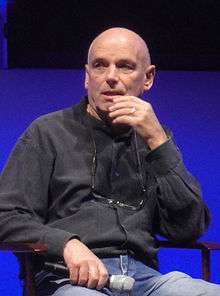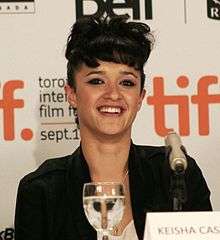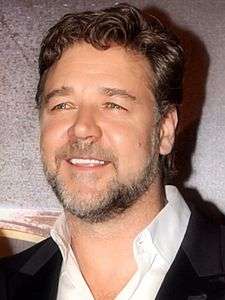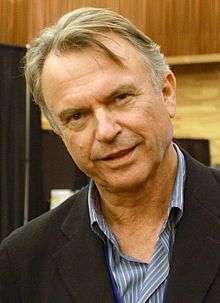Cinema of New Zealand
| Cinema of New Zealand | |
|---|---|
 The Skycity Village Cinemas next to Aotea Square in Auckland City, New Zealand. | |
| Number of screens | 411 (2010)[1] |
| Produced feature films (2011)[2] | |
| Fictional | 19 |
| Animated | 1 |
| Documentary | 5 |
| Number of admissions (2010)[1] | |
| Total | 15,300,000 |
| • Per capita | 3.6 (2010)[3] |
| Gross box office (2012)[4] | |
| Total | $145 million |
| National films | $3.19 million (2.20%) |
New Zealand cinema, can refer to films made by New Zealand-based production companies in New Zealand. However, it may also refer to films made about New Zealand by filmmakers from other countries. In addition, due to the relatively small size of its film industry, many New Zealand-made films are co-productions with companies based in other nations.
Film has a long history in New Zealand. The first public screening of a motion picture was in 1896; a 1900 documentary is the oldest surviving New Zealand film - and the first feature film made in New Zealand premiered in 1914. However, although there was a small-scale industry during the 1920s-1960s, it wasn't until the 1970s that New Zealand made films were able to attract large-scale audiences.
From the 1990s onward, a steady flow on New Zealand made films have had international success, including both those with local funding and themes, and those such as the Lord of the Rings trilogy, made with Hollywood money.
Defining New Zealand Film
In October 1978 the New Zealand Film Commission was formalised by Parliament under the Third National Government. The functions of the Commission under Section 17 of the New Zealand Film Commission Act 1978 were to:[5]
- Encourage and assist in the making, promotion, distribution and exhibition of films
- Encourage and promote cohesion with NZ film industry
- Encourage and promote maintenance of films in archives
With this Act, the New Zealand film industry became more stabilised. Section 18 of the Act, entitled "Content of Films", would serve to define which aspects a film had to have in order for it to be labelled as a New Zealand Film. To qualify as a New Zealand film, the film must have "significant New Zealand content", taking into account the following:[5]
- The subject of the film
- The locations at which the film was made
- The nationalities or places of residence of:
- the authors, scriptwriters, composers, producers, directors, actors, technicians, editors, etc.
- the owners of any company, partnership, or joint venture involved in making the film
- the copyright holders
- The sources from which the money is derived
- The ownership and whereabouts of the equipment and technical facilities
These defining aspects have in recent years caused debate on whether films like The Frighteners and the The Lord of the Rings qualify as New Zealand Films. The impact of the New Zealand Film Commission on the industry was in getting films made, coming to a definition of NZ Film, and helping establish a Screen Industry in New Zealand.
Most New Zealand films are made by independent filmmakers, often on a low budget and with sponsorship from public funds. Relatively few New Zealand-made films have been specifically commissioned for the international market by international film distributors.
Recently, international film companies have become more aware of the skills of New Zealand filmmakers, and have increasingly used the New Zealand film industry as a base to shoot and also sometimes finish their feature films.
Private funding for New Zealand films has often been in short supply, although for a period in the early eighties tax-breaks resulted in a rush of money and a production boom. Although the trend seems to be changing for the better, some New Zealand directors and actors have been ignored in large part by their own country, despite success overseas, and often had to work in the US, Australia, and the UK as a result.
History
Early film: 1890s-1920s
The first public screening of a motion picture was on 13 October 1896 at the Opera House, Auckland and was part of a show presented by Charles Godfrey’s Vaudeville Company.[6]
The first screening of a colour film (colour process, not just a colourised black and white film) was on Christmas Eve in 1911. It was a simultaneous showing at the Globe Picture Theatre, Queen Street and the Kings Theatre, Upper Pitt Street (now Mercury Lane).
The first filmmaker in New Zealand was Alfred Whitehouse, who made ten films between 1898 and mid-1900. The oldest surviving New Zealand film is Whitehouse's The Departure of the Second Contingent for the Boer War (1900).
The first feature film made in New Zealand is arguably Hinemoa. It premiered on 17 August 1914 at the Lyric Theatre, Auckland.[7][8]
New Zealand's oldest surviving cinema is the Roxburgh cinema, located in Central Otago. It was opened on 11 December 1897 [9] and is still open.
The classical era: 1920s-1960s
New Zealand film was a small-scale industry during the 1920s-1960s. During the 1920s and 1930s, director Rudall Hayward made a number of feature films on New Zealand themes. Rewi's Last Stand was probably his best, but little of this 1925 film survives. The film was remade with sound in 1940. Independent filmmaker John O'Shea was active from 1940 to 1970 making New Zealand cinema; his company Pacific Films produced numerous short films as well as the three New Zealand feature films made in that period: Broken Barrier (1952) with Roger Mirams, Runaway (1964), and Don't Let It Get You (1966).
However, during this period, most New Zealand-made films were documentaries. The National Film Unit was a government-funded producer of short films, documentaries, and publicity material. This is New Zealand, a short film made for the World Expo in 1970 was extremely popular there and subsequently screened in New Zealand cinemas, to much public acclaim. It used three projectors onto a wide screen, and was restored in 2004–05 and later re-released.
Establishment of the New Zealand Film Commission: 1970s and 1980s
In 1978, the New Zealand Film Commission was established to fund the production of New Zealand cinema films.[10] It's aim was to ecourage and promote the national film industry, and a number of film projects have been funded by the commission.[10]
One of the first New Zealand films to attract large-scale audiences at home was Sleeping Dogs, directed by Roger Donaldson in 1977.[11] A dark political action thriller that portrays the reaction of one man to the formation of a totalitarian government, and subsequent guerrilla war in New Zealand, it introduced Sam Neill as a leading actor.[11] The imagery of large-scale civil conflict and government repression was seen only a few years later when the 1981 Springbok Tour caused nationwide protests and police response.[12]
Sleeping Dogs was also notable for being the first full-length 35mm feature film made entirely by a New Zealand production crew.[13] Before then, feature films such as 1973's Rangi's Catch had been filmed and set in New Zealand, but were still produced and directed by foreign crews.[13]
1981 saw the release of the road film Goodbye Pork Pie, which made NZ$1.5 million.[14] Director Geoff Murphy was lured away by Hollywood, but he made two other key New Zealand films, Utu, (1983), about the land wars of the 1860s, and The Quiet Earth (1985) a science fiction film.[15] Both films featured Bruno Lawrence, who became a film star in the country.[16]
Melanie Read was the first woman to write and direct a New Zealand feature film with the 1984 thriller Trial Run.[17]
In 1987 Barry Barclay's film Ngati, screenplay by Tama Poata and starring veteran actor Wi Kuki Kaa, was released to critical acclaim and some box-office success. Ngati is recognised as the first feature film to be written and directed by a member of the Maori.[18]
Merata Mita was the first Maori woman to write and direct a dramatic feature film, when she directed Mauri in 1988.[19] An accomplished documentary film-maker, Mita made landmark documentaries including Bastion Point: Day 507, a film about the Ngāti Whātua in 1980, and Patu! in 1983, a film about the controversial and violent anti-apartheid protests during the 1981 Springboks rugby tour from South Africa .[20]
During the late 1980s a trend developed that saw the reinvention of the New Zealand short film, such as Alison Maclean's short film Kitchen Sink.[21] Instead of trying to be short features focused on dialogue and character, the new shorts tried instead to push the envelope in terms of visual design and cinematic language.[21] The result saw an explosion of visually rich and compelling works that seemed to aspire more to the best of European cinema than the mainstay of Hollywood fare.[22]
Key examples of these New Zealand short films are: The Lounge Bar (The Front Lawn), Kitchen Sink (Alison Maclean), A Little Death (Paul Swadel), Stroke (Christine Jeffs), La Vie En Rose (Anna Reeves), A Game With No Rules (Scott Reynolds), Eau de la vie (Simon Baré), O Tamaiti (The Children) (Sima Urale) which won the Silver Lion Best Short Film at the Venice Film Festival;[23] and Two Cars, One Night (Taika Waititi) which was nominated Best Short Film at the Academy Awards.[24]
International breakthrough: 1990s-2005

The early 1990s saw New Zealand film gain international recognition, most obviously with Jane Campion's The Piano (1993), which won three Academy Awards. Peter Jackson's Heavenly Creatures (1994) and Lee Tamahori's Once Were Warriors also gained international critical acclaim and high grosses in a number of countries. The first two examples showed an increasing tendency for New Zealand films to be partially or completely overseas-funded, and also star non-New Zealand actors (Holly Hunter and Harvey Keitel in The Piano and Kate Winslet in Heavenly Creatures). This did not stop the migration of New Zealand talent to the United States: Tamahori, Melanie Lynskey of Heavenly Creatures and Canadian-born Piano star Anna Paquin are now all primarily based in America, and some of the Warriors cast also found work there.
A notable exception to the migration tendency is Peter Jackson, who has continued to make films in New Zealand. Jackson's career began with low-budget comedy movies, such as Bad Taste (1987) and Meet the Feebles (1989). He gradually became noticed by Hollywood, and directed the phenomenally successful The Lord of the Rings films. Although made with mainly American money (and an advantageous tax break from the New Zealand government) and a primarily international cast, Jackson filmed the movies in New Zealand, using a largely Kiwi production crew, helping create an enormous skill base in the New Zealand film industry.
This has led to a number of prominent Hollywood films being made in New Zealand, with major international productions not only filming there but also using the various post-production facilities and special effects companies on offer. The resulting films include The Last Samurai and The Chronicles of Narnia: The Lion, the Witch and the Wardrobe. While the funding for these movies is largely American, it has helped New Zealand film studios and filmmakers develop their skills and improve their facilities. The audiences of Bollywood fell in love with New Zealand after the super hit movie Kaho Naa... Pyaar Hai was released in 2000, starring Hrithik Roshan.
However, some industry figures claim that having large international productions employ New Zealanders has its downside. One New Zealand filmmaker recently highlighted how difficult it was to employ cameramen when working on a low-budget New Zealand film, as cameramen are now used to receiving large wages.[25] Other film makers find that the opposite is true, and argue that the greater number of local professionals may actually have driven wages down from the relative heights of the 1980s. Another alleged downside is that the big-budget internal productions swallow up any funding New Zealand has available, making it far more difficult for local productions to find money.
Despite this, local content has also significantly increased with Whale Rider (directed by Niki Caro - 2002) becoming the second highest grossing North American Independent Film (2003) and third highest worldwide earning $40.1 million. Other notable films include In My Father's Den (directed by Brad McGann - 2004) and The World's Fastest Indian (directed by Roger Donaldson - 2005). Both films have done very well at the New Zealand box-office, with The World's Fastest Indian beating the record held by Once Were Warriors to become the highest grossing New Zealand film at the domestic box-office, taking in over $6.5 million. This record was again beaten in 2010 by Boy (directed by Taika Waititi - 2010).
An important and accessible retrospective of New Zealand film, Sam Neill and Judy Rymer's Cinema of Unease was made in 1995. The film presented the history of New Zealand film from the personal perspective of Sam Neill.
2006-present
.jpg)
The latter part of the first decade in 21st Century New Zealand saw the expansion of Peter Jackson's filmmaking empire with Jackson optioning the rights to The Lovely Bones, Halo, The Dam Busters and the fantasy dragon series Temeraire. Major productions such as James Cameron's Avatar and the 2007 summer blockbuster The Water Horse: Legend of the Deep are also utilising Jackson's Wellington studios and enlisting special effects giant Weta Digital.
Eagle vs Shark was director Taika Waititi's first feature film, starring Jemaine Clement and Loren Horsley, and was released in 2007. The film earned over US $1 million at the box office.[26] Waititi's film Boy, released in 2010, topped the box office receipts for the opening week, earning more on its opening day than any previous New Zealand film.[27] Boy became the highest grossing New Zealand film on its own soil.[28] In 2014 the mockumentary What We Do in the Shadows, directed by Waititi and Clement, was released, to substantial critical acclaim.[29] Two years later Waititi released Hunt for the Wilderpeople, starring Sam Neill and Julian Dennison, a film that became the new highest grossing opening weekend box office New Zealand film on home soil, beating the record set by his own film from six years previously.[30]
The Ground We Won is a 2015 slice-of-life film following a rural rugby team through the triumphs and challenges of their season. [31]
New Zealand Film Archive
The New Zealand Film Archive was founded and incorporated on 9 March 1981. Film enthusiast, critic and historian Jonathan Dennis (1953 – 2002) was a primary driving force behind the archive and became its first director. The archive was set up to preserve and restore significant New Zealand film and television images. It now holds a collection of much of early New Zealand cinema film and holds public screenings of its collection.
Much of the early cinema film made in New Zealand has been lost, as it was printed on unstable nitrate film base. In 1992, when film enthusiasts and the New Zealand Film Archive realised how much of New Zealand's film heritage was being lost, they mounted the Last Film Search and found 7,000 significant films, both in New Zealand and around the world.
Highest-grossing New Zealand films
 Background shading indicates films playing in the week commencing 02 December 2016 in theaters around the world.
Background shading indicates films playing in the week commencing 02 December 2016 in theaters around the world.
| Rank | Title | Year of release | Director | New Zealand gross (NZ$)[32] | Worldwide gross (US$)[33] |
|---|---|---|---|---|---|
| 1 | Whale Rider | 2003 | Niki Caro | $6,400,000 | $41,442,113 |
| 2 | Hunt for the Wilderpeople | 2016 | Taika Waititi | $12,166,498 | $24,785,492 |
| 3 | The World's Fastest Indian | 2005 | Roger Donaldson | $7,047,000 | $18,297,690 |
| 4 | Boy | 2010 | Taika Waititi | $9,322,000 | $8,621,535 |
| 5 | Once Were Warriors | 1994 | Lee Tamahori | $6,795,000 | $6,928,340 |
| 6 | What We Do in the Shadows | 2014 | Taika Waititi and Jemaine Clement | $2,595,000 | $6,263,224 |
| 7 | Sione's Wedding | 2006 | Chris Graham | $4,075,000 | $2,993,332 |
| 8 | Second Hand Wedding | 2008 | Paul Murphy | $1,913,000 | $1,912,330 |
| 9 | What Becomes of the Broken Hearted? | 1999 | Ian Mune | $3,201,000 | |
| 10 | Footrot Flats: The Dog's Tale | 1986 | Murray Ball | $2,420,000 | |
Films such as the Lord of the Rings or the Hobbit film series are not classified as New Zealand films under the New Zealand Film Commission Act 1978, so are not included in the list of highest-grossing films. However, there are many more films that have been filmed in New Zealand which have been very successful internationally.
| Rank | Title | Year of release | Director | Filming location | Worldwide gross (US$)[33] |
|---|---|---|---|---|---|
| 1 | Avatar | 2009 | James Cameron | Wellington | $2,787,965,087 |
| 2 | The Lord of the Rings: The Return of the King | 2003 | Peter Jackson | New Zealand-wide | $1,119,929,521 |
| 3 | The Hobbit: An Unexpected Journey | 2012 | Peter Jackson | New Zealand-wide | $1,021,103,568 |
| 4 | The Hobbit: The Battle of the Five Armies | 2014 | Peter Jackson | New Zealand-wide | $956,019,788 |
| 5 | The Hobbit: The Desolation of Smaug | 2013 | Peter Jackson | New Zealand-wide | $958,366,855 |
| 6 | The Lord of the Rings: The Two Towers | 2002 | Peter Jackson | New Zealand-wide | $926,047,111 |
| 7 | The Lord of the Rings: The Fellowship of the Ring | 2001 | Peter Jackson | New Zealand-wide | $871,530,324 |
| 8 | King Kong | 2005 | Peter Jackson | Wellington and Auckland | $550,517,357 |
| 9 | The Last Samurai | 2003 | Edward Zwick | Taranaki Region | $456,758,981 |
| 10 | The Adventures of Tintin: Secret of the Unicorn | 2011 | Steven Spielberg | Wellington | $373,993,951 |
Personalities
-

Martin Campbell, BAFTA winner, director of Casino Royale
-

Keisha Castle-Hughes, Academy Award nominee for Whale Rider
-

Jane Campion, Academy and Golden Palm winner for The Piano
-

Jemaine Clement, What We Do in the Shadows actor and director
-

Russell Crowe, Academy Award winner for Gladiator
-

Peter Jackson, Academy Award-winner, director of The Lord of the Rings
-

Lucy Lawless, star of Xena: Warrior Princess
-
.jpg)
Bret McKenzie, Grammy Award-winner for The Muppets
-

Sam Neill, Emmy and Golden Globe nominee, star of Jurassic Park
-

Andrew Niccol, BAFTA winner, director of Gattaca
-

Anna Paquin, Academy Award winner for The Piano, star of True Blood
-

Karl Urban, star of Dredd
-

Taika Waititi, Academy Award nominee, Hunt for the Wilderpeople director
Other notable feature directors
| Name | Notable works | Notes |
|---|---|---|
| Andrew Adamson | Shrek 1 and 2, The Narnia film series | Academy Award-winner |
| Niki Caro | Whale Rider, North Country | BAFTA- winner |
| Roger Donaldson | Dante's Peak, Cocktail, The World's Fastest Indian, The Recruit | Golden Palm-nominee |
| Ellory Elkayem | Eight Legged Freaks | |
| Ian Mune | Came a Hot Friday, What Becomes of the Broken Hearted? | Notable also as actor and screenwriter |
| Geoff Murphy | Goodbye Pork Pie, Young Guns II | |
| Melanie Rodriga | Teesh and Trude | Nominated for three AACTA Awards |
| Robert Sarkies | Scarfies, Out of the Blue, Two Little Boys | |
| Lee Tamahori | Die Another Day, Along Came a Spider, Once Were Warriors | |
| Vincent Ward | River Queen, What Dreams May Come | Two-time Golden Palm nominee |
Other notable actors
See also
- List of cinema of the world
- Wellywood
- World cinema
- List of New Zealand film makers
- List of New Zealand films
References
- 1 2 "A trip to the flicks: watching cinema admission prices in the CPI". Statistics New Zealand. Retrieved 7 November 2013.
- ↑ "Table 1: Feature Film Production - Genre/Method of Shooting". UNESCO Institute for Statistics. Retrieved 5 November 2013.
- ↑ "Cinema - Admissions per capita". Screen Australia. Retrieved 9 November 2013.
- ↑ "Market Study - New Zealand" (PDF). German Films. Retrieved 9 November 2013.
- 1 2 "New Zealand Film Commission Act 1978 No 61 (as at 1 July 2013) -- New Zealand Legislation Online". Parliamentary Counsel Office. 1 July 2013. Retrieved 1 October 2014.
- ↑ MIC - Film pioneers
- ↑ "Tracking Shots: Close Ups on NZ Film History: Hinemoa". New Zealand Film Archive. Retrieved 2008-09-08.
- ↑ "THE CINEMA IN NZ IS ONE HUNDRED YEARS OLD". KiWiphile FILE - the News Aerogramme of New Zealand. VIII (8): 4. June 1996. Retrieved 2008-09-08.
- ↑ Mount Benger Mail, 10 December 1897 (Hocken Library, Dunedin)
- 1 2 Jackson, Peter; Court, David (June 2010). Review of the New Zealand Film Commission (PDF) (Report). p. 4. Retrieved 25 July 2016.
- 1 2 "Sleeping Dogs (1977)". Cinema Aotearoa. Retrieved 25 July 2016.
- ↑ "Sleeping Dogs". Moria.co.nz. Moria. Retrieved 25 July 2015.
- 1 2 Martin, Helen; Edwards, Sam (1997). New Zealand Film 1912-1996. Auckland: Oxford University Press. ISBN 019 558336 1.
- ↑ Mike Nicolaidi (March 1986). New Zealand (Report). Cinema Papers. p. 8.
- ↑ "Geoff Murphy Filmography". Internet Movie Database. Retrieved September 29, 2012.
- ↑ "Bruno Lawrence". Internet Movie Database. Retrieved 25 July 2016.
- ↑ https://www.nzonscreen.com/title/trial-run-1984/credits
- ↑ https://www.nzonscreen.com/title/ngati-1987/overview
- ↑ http://www.wiftauckland.org.nz/merata-mita-13
- ↑ http://www.nzonscreen.com/person/merata-mita/biography
- 1 2 http://pov.imv.au.dk/Issue_13/section_4/artc2A.html
- ↑ http://folksonomy.co/?permalink=174 Paul Shannon, 1995
- ↑ http://qag.qld.gov.au/collection/pacific_art/sima_urale Queensland Art Gallery, Contemporary Pacific Art Collection
- ↑ https://www.nzonscreen.com/title/two-cars-one-night-2003
- ↑ http://www.iht.com/articles/2005/12/29/style/fmlede30.php
- ↑ "Eagle Vs. Shark (2007)". Box Office Mojo. Retrieved 1 July 2010.
- ↑ McDonald, Greer (29 March 2010). "Boy a hit at Kiwi box office". Stuff.co.nz. Archived from the original on 15 August 2010. Retrieved 15 August 2010.
- ↑ "Wellington director's feature to be the highest-grossing NZ production". Scoop. 22 May 2010. Archived from the original on 15 August 2010. Retrieved 15 August 2010.
- ↑ Taylor, Drew (14 March 2014). "SXSW Review: Vampire Comedy 'What We Do In The Shadows' Draws Blood". Indiewire. Retrieved 19 March 2014.
- ↑ "Hunt for the Wilderpeople breaks Kiwi box office records". Stuff.co.nz. 4 April 2016. Retrieved 10 April 2016.
- ↑ . 2015 http://thegroundwewon.com/. Retrieved 7 October 2016. Missing or empty
|title=(help) - ↑ Top Twenty New Zealand Films Released At New Zealand Box Office (to 21 September 2016) (PDF) (Report). New Zealand Film Commission. 1 July 2016. p. 1. Retrieved 8 July 2016.
- 1 2 http://www.boxofficemojo.com/

